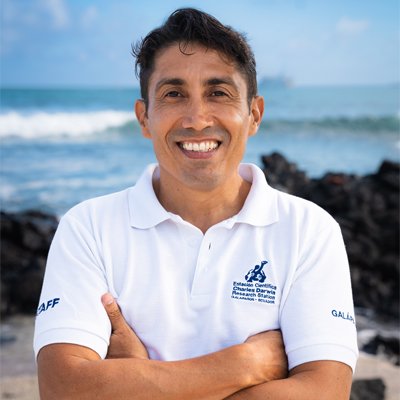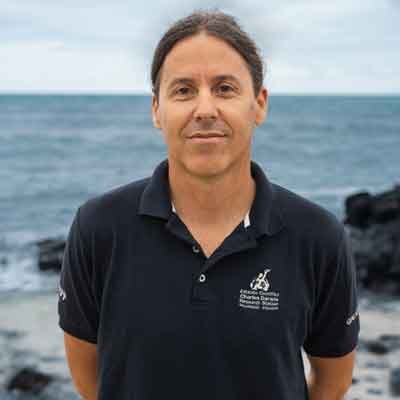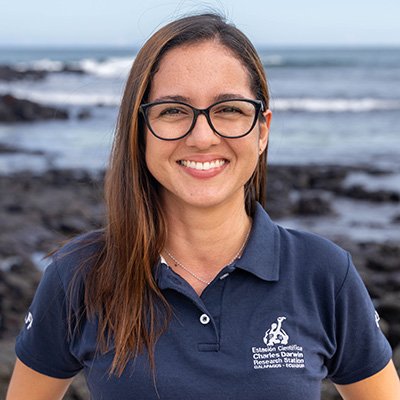Galapagos penguins, flightless cormorants, waved albatross, and flamingos are among the most iconic birds in Galapagos. Yet, these sentinel species are all classified as threatened on the International Union for Conservation of Nature’s Red List, and face continued risk of population decline.
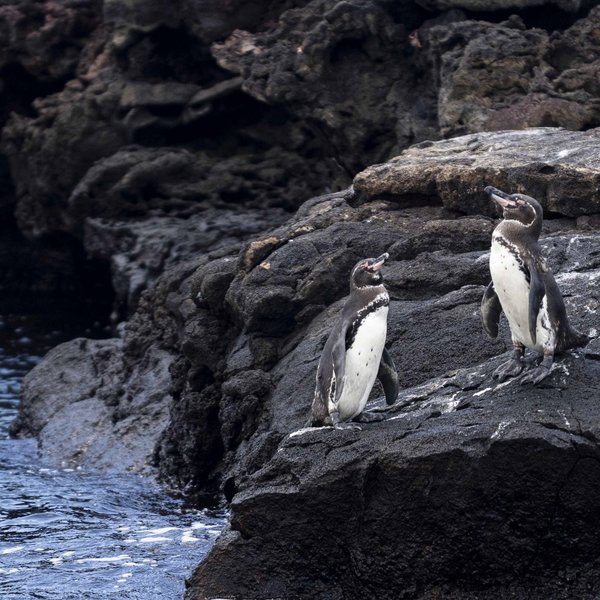
Our team
Gustavo Jiménez Uzcátegui
Principal Investigator - Marine Bird Conservation
Nicolás Moity
Senior Researcher in Marine Sciences & Geospatial expert
Andrea Daniela Coloma
Research assistant
Jonathan Cueva
Research Assistant
Diego Núñez
Administrative Science Manager
Collaborators
Christian Sevilla, Andrea Loyola (GNPD)
Kate Huyvaert (Washington State University)
Patricia Parker, Sage Rohrer (Missouri University)
R. Lenin Vinueza, David Egas (Universidad San Francisco de Quito)
Richar Rodriguez (Universidad Central del Ecuador)
Karine Laroucau, Gina Zanella, (Agence nationale de Sécurité Sanitaire)
Hernán Vargas (Fondo Peregrino)
Paco Bustamante (Université de La Rochelle)
Andreas Nord (Lund University)
Peter L. Pap (Babes-Bolyai University, Cluj-Napoca)
Alice Skehel (University of Sunshine Coast)
Donors
Oceans Finance Company
COmON Foundation
The challenge
Galapagos penguins and flightless cormorants are represented by very small populations of between 2,000 to 3,000 individuals spread out around the archipelago. The endemic flamingos have an even smaller population estimated at around 600 individuals. Because their populations are so small, they face heightened risk of population declines due to external threats such as climate change (El Niño events - ENSO); pathogens such as the Avian (Influenza) Flu; invasive species such as rats, cats and pigs; and human interactions such as bycatch, and pollution from plastics and heavy metals.
Waved albatross populations are much larger and estimated at around 35,000 individuals, but they breed only on a single island in the archipelago, Española Island. This makes the entire population vulnerable to external threats like pathogens and invasive species. Notably, their greatest threat comes from human interaction outside the Galapagos Marine Reserve (GMR), primarily through entanglement in fishing gear (bycatch).


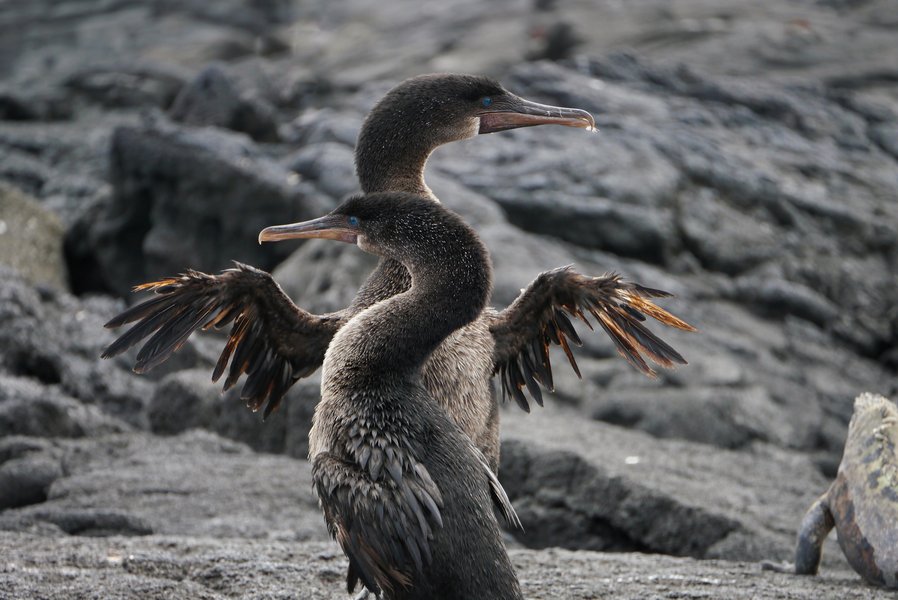
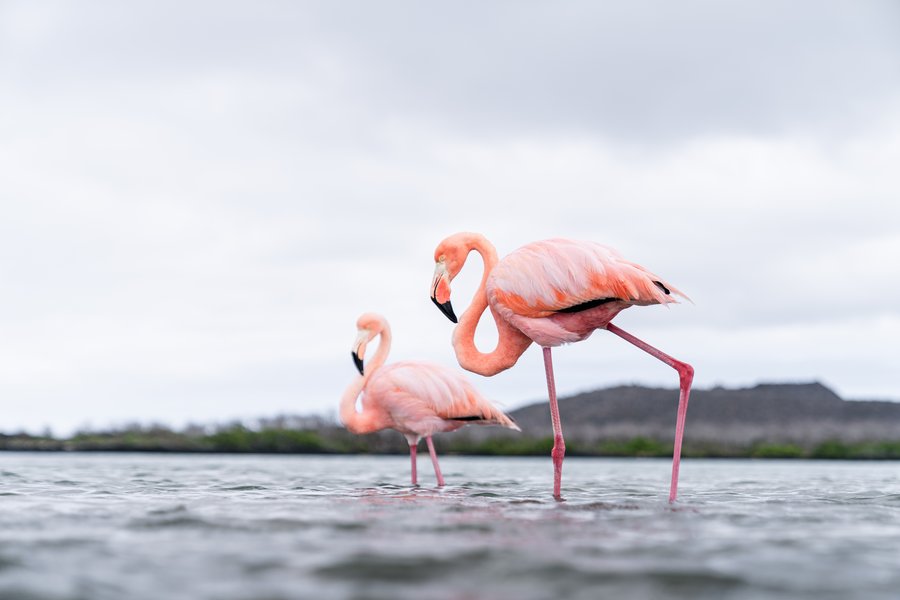
All these remarkable creatures act as sentinel species, providing early warning signs of potential threats to the delicate balance of the Galapagos archipelago and even to human health.
Understanding the impact of threats faced by these sentinel species is key to safeguarding their future and the health of the entire Galapagos ecosystem. To protect these remarkable species, ongoing and long-term population monitoring and health controls are essential. By studying their long-term population fluctuations, our scientists can help authorities design and implement more effective plans to ensure their long-term conservation.
What We Do
Charles Darwin Foundation (CDF) researchers work on multiple fronts to track the populations and health of these iconic sea and lagoon bird species. All the data we generate is provided to the Galapagos National Park Directorate (GNPD) with appropriate recommendations for conservation action and shared with the local community, guides, rangers, and the broader scientific community.
Providing Crucial Population Statistics
Our researchers conduct systematic population monitoring to gather data on survival, mortality, and reproduction rates for each species in relations to their specific threats. These data are critical to understanding population trends and identifying threats, and to informing the GNPD on critical conservation priorities. Monitoring of penguins and cormorants takes place twice a year on the islands of Isabela, Fernandina, Marielas, Floreana, Santiago, and Bartolomé. Monitoring of flamingos also takes place twice a year in the brackish lagoons of Santa Cruz, Floreana, Santiago, Rábida, Bainbridge and Isabela islands. Monitoring of the albatross is done once a year on Española Island.
Mitigating the Impacts of Introduced Species
We actively research and implement strategies to reduce the harmful effects of invasive predators and competitors on seabird nesting success and survival, such as rats and cats on Isabela Island. This may involve invasive species control, with physical-chemical methods.
Monitoring New Diseases
We monitor the introduction of new pathogens (diseases) in the principal colonies of the marine and coastal sentinel birds, and also assess other species such as boobies, gulls and ducks to provide management recommendations to GNPD and the Galapagos Biosecurity Agency.
Understanding the Interactions Between the Ecosystem and Climate Change
We investigate the complex interconnections between the four bird species and the wider Galapagos ecosystem. This includes studying their food webs, habitat requirements, and responses to environmental changes with particular attention on climate change. By gaining a deeper understanding of the ecosystem's health and the threats posed by climate change, we can develop effective long-term conservation strategies.
Program Objectives
- Acquire a better understanding of species survival and reproduction rates through capture-recapture - a widely used ecological technique for estimating the population size of wild animals.
- Provide information on long-term population trends for penguins, cormorants and flamingos by comparing new data with historical data.
- Evaluate the population status of introduced species and implement control actions in key breeding areas.
- Evaluate the health of sentinel species populations, including monitoring for diseases and heavy metals.
- Monitor seabird species movement patterns and behavior as indicators of local-level ecosystem health.
- Collect meteorological data in selected penguin and cormorant colonies to determine the impacts of climate change.

Our Impact
Establishing Effective Seabird Management Regulations
Our work in collaboration with the GNPD and other institutions has led to the establishment of effective seabird management regulations in the GMR. These were successfully implemented during the 2023 Avian flu outbreak, including closing key breeding sites to visitors, and implementing safety protocols in the poultry and tourism industries, which helped to significantly contain the spread of the virus via human contact.
Conserving Albatrosses and Petrels
Our work has contributed to the success of the multilateral Agreement on the Conservation of Albatrosses and Petrels (ACAP), an international treaty dedicated to the conservation of these magnificent birds. Our efforts have played a vital role in protecting seabird populations far beyond the borders of Galapagos.
Key Species Recognition
We successfully established seabirds and lagoon birds as key species within the Galapagos ecosystem, highlighting their importance to the overall health and balance of the environment. This recognition has led to increased scientific research and a deeper understanding of their population dynamics.
Pioneering Research
We conducted the first studies ever undertaken on the presence of endoparasites, heavy metals (lead, cadmium, and mercury), stable isotopes, clinical-medical parameters, and age records in these bird species. This groundbreaking research provided valuable insights into their health, diet, and the potential threats they face.
Why It Matters
Sea and lagoon birds are often considered sentinel species, meaning they are sensitive to changes in the environment and can provide valuable early warnings of potential problems. By monitoring these bird populations in Galapagos, we gain vital insights into the overall health and well-being of the archipelago’s ecosystem. Declines in seabird abundance or reproductive success can indicate broader environmental issues that require attention.
They also play important roles in the Galapagos ecosystem, performing vital functions in nutrient cycling, and in maintaining ecological balance through predation.
Our long-term population studies require dedicated efforts that enable us to identify key trends that inform effective management actions and proactive measures for safeguarding threatened sea and lagoon bird species. For example, our extensive research on the effects of El Niño events on penguin and cormorant populations has been instrumental in anticipating potential threats and preparing accordingly.

Why You Should Support Us
For over a decade, our dedicated researchers have been collecting vital data on the Galapagos penguin, flightless cormorant, waved albatross, flamingos and other water birds. This extensive dataset has significantly contributed to our scientific understanding of these remarkable species and serves as a crucial foundation for informed conservation decisions.
Here are some specific examples of how your donation could be used:
- Fund our bi-annual field trips to monitor penguin, cormorant and flamingo populations, and our annual trip to Española to monitor albatross.
- Support the acquisition of essential materials such as gloves and protective gear used when conducting health checks on wild birds.
- Enable funding for laboratory analyses of heavy metals and diseases, including pathogens and parasites.
- Engage more researchers in peak field periods to cover more ground in our population monitoring activities and in times of crises (such as the 2023 Avian flu outbreak).

Protect Galapagos, Impact the World
The impact you make on this small ecosystem of enormous biodiversity is part of a larger footprint you are leaving for the world's future. Join us on our mission to safeguard one of our planet’s most important natural treasures through science and conservation action by making a donation today. Thank you for making an impact with us.




